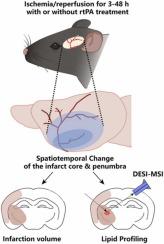Pharmacological Research ( IF 9.1 ) Pub Date : 2022-10-03 , DOI: 10.1016/j.phrs.2022.106482 Yinzhong Ma 1 , Zhiyu Chen 2 , Qianyan He 3 , Zhen-Ni Guo 4 , Yi Yang 4 , Fulin Liu 5 , Fang Li 6 , Qian Luo 2 , Junlei Chang 1

|
Reperfusion therapy with recombinant tissue plasminogen activator (rtPA) or mechanical thrombectomy is the most effective treatment for ischemic stroke. However, a large proportion of stroke patients remain severely disabled even after receiving timely reperfusion therapy. It remains unclear how reperfusion therapy results in secondary injury to the brain tissue and whether different reperfusion therapies induce differential effects. Here, we comprehensively determined the spatiotemporal dynamic changes in brain lipids during the acute phase after reperfusion in a mouse model of transient middle cerebral artery occlusion, with or without rtPA administration, using desorption electrospray ionization (DESI)-mass spectrometry imaging (MSI). Several phospholipids, sphingolipids, and neutral lipids were significantly altered both spatially and temporally at multiple timepoints after reperfusion, many of which were closely associated with expansion of the brain infarction territory and neurological function impairment. Furthermore, rtPA treatment significantly increased brain infarction, cerebral edema, and neurological deficits. Consistently, rtPA treatment caused extensive brain lipid alterations by facilitating brain-wide changes in lipid metabolism and inducing ischemic region-specific lipid changes. Overall, these results provide novel insights into how reperfusion therapy affects brain tissue and the outcome of stroke patients, and thus may facilitate the optimization of the treatment of ischemic stroke.
中文翻译:

时空脂质组学揭示脑缺血再灌注治疗后脑脂质动态变化的关键特征
使用重组组织纤溶酶原激活剂 (rtPA) 或机械血栓切除术进行再灌注治疗是缺血性卒中最有效的治疗方法。然而,即使在及时接受再灌注治疗后,仍有很大一部分脑卒中患者严重致残。目前尚不清楚再灌注治疗如何导致脑组织继发性损伤,以及不同的再灌注治疗是否会产生不同的效果。在这里,我们使用解吸电喷雾电离(DESI)-质谱成像 (MSI)全面确定了短暂大脑中动脉闭塞小鼠模型再灌注后急性期脑脂质的时空动态变化,无论是否给予 rtPA 。几种磷脂,鞘脂和中性脂质在再灌注后的多个时间点在空间和时间上都发生了显着变化,其中许多与脑梗死区域的扩大和神经功能障碍密切相关。此外,rtPA 治疗显着增加脑梗塞、脑水肿和神经功能缺损。一致地,rtPA 治疗通过促进全脑脂质代谢变化和诱导缺血区域特异性脂质变化而引起广泛的脑脂质改变。总体而言,这些结果为再灌注治疗如何影响脑组织和中风患者的预后提供了新的见解,因此可能有助于优化缺血性中风的治疗。


















































 京公网安备 11010802027423号
京公网安备 11010802027423号